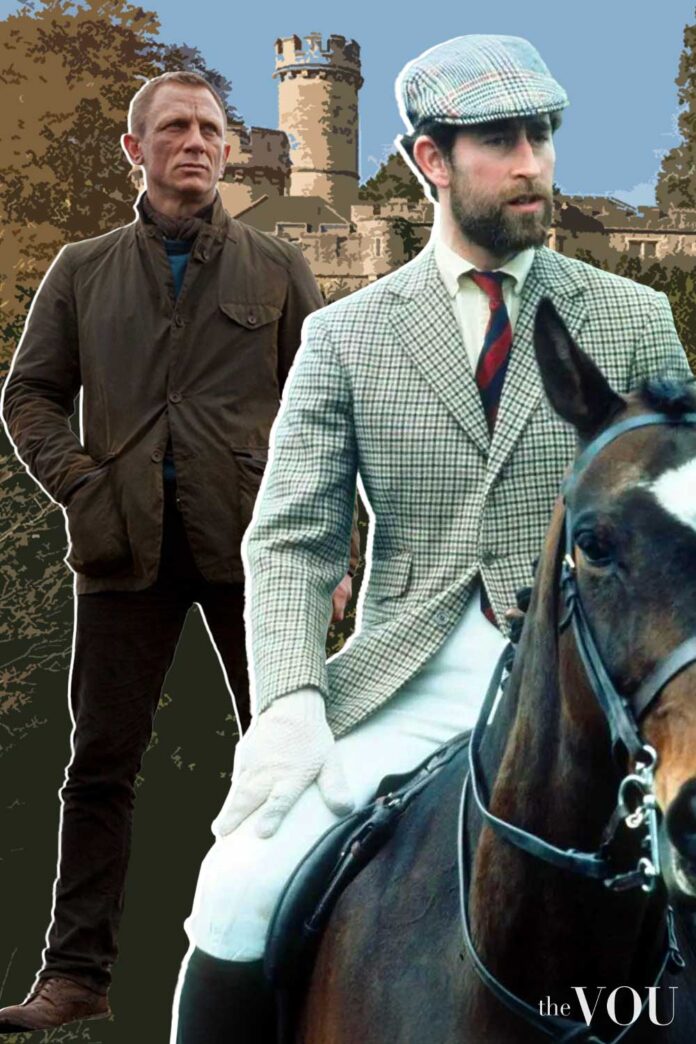In this article, we’ll explore British Country Chic’s rich history, key figures, and the essential components that make this quintessentially British style.
Join us on this sartorial journey through the fields and forests of British fashion history, where we uncover the secrets of colour and pattern mixing and the art of adapting this heritage look for modern settings.
What is British Country Chic Style
British Country Chic style is rooted in the verdant landscapes and aristocratic traditions of 19th-century Britain and stands as a testament to the allure of countryside elegance.
Born from the needs of the landed gentry and shaped by the rhythms of rural life, the British Country Chic style has become a fashion statement that resonates far beyond the rolling hills of the British Isles.
While British Country Chic shares certain visual aspects with broader countryside attire, it distinguishes itself through its aristocratic lineage and meticulous attention to detail.
Unlike the more relaxed Sloane Ranger style, which borrows heavily from country fashion, true Country Chic eschews casual country wear in favour of a structured, heritage-driven traditional dress code.
Style’s Origin
The genesis of British Country Chic can be traced to the grand estates and sprawling manors that dotted the English countryside during the Victorian era where a unique dress code emerged amid the pursuit of field sports and outdoor pursuits.
Hunting parties, shooting expeditions, and fishing excursions demanded attire that could withstand the rigours of the British climate whilst maintaining an air of refinement befitting the upper echelons of society.
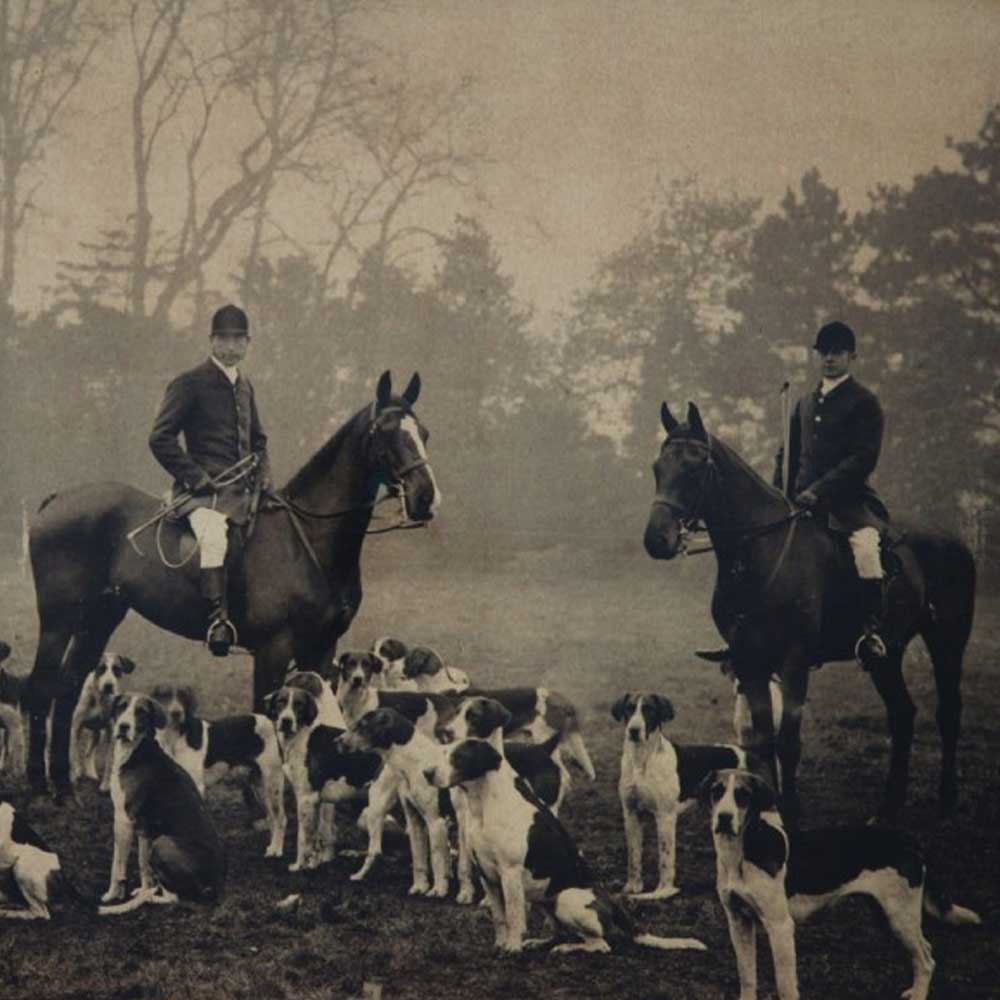
As the Industrial Revolution swept through Britain, it brought innovations in textile production that would prove instrumental in shaping the Country Chic aesthetic.
The advent of mechanised looms and advanced dyeing techniques allowed for the creation of robust yet refined fabrics, most notably the iconic tweed.
This hardy wool cloth, with its distinctive patterns and earthy hues, became the cornerstone of the country wardrobe, embodying practicality and sophistication.
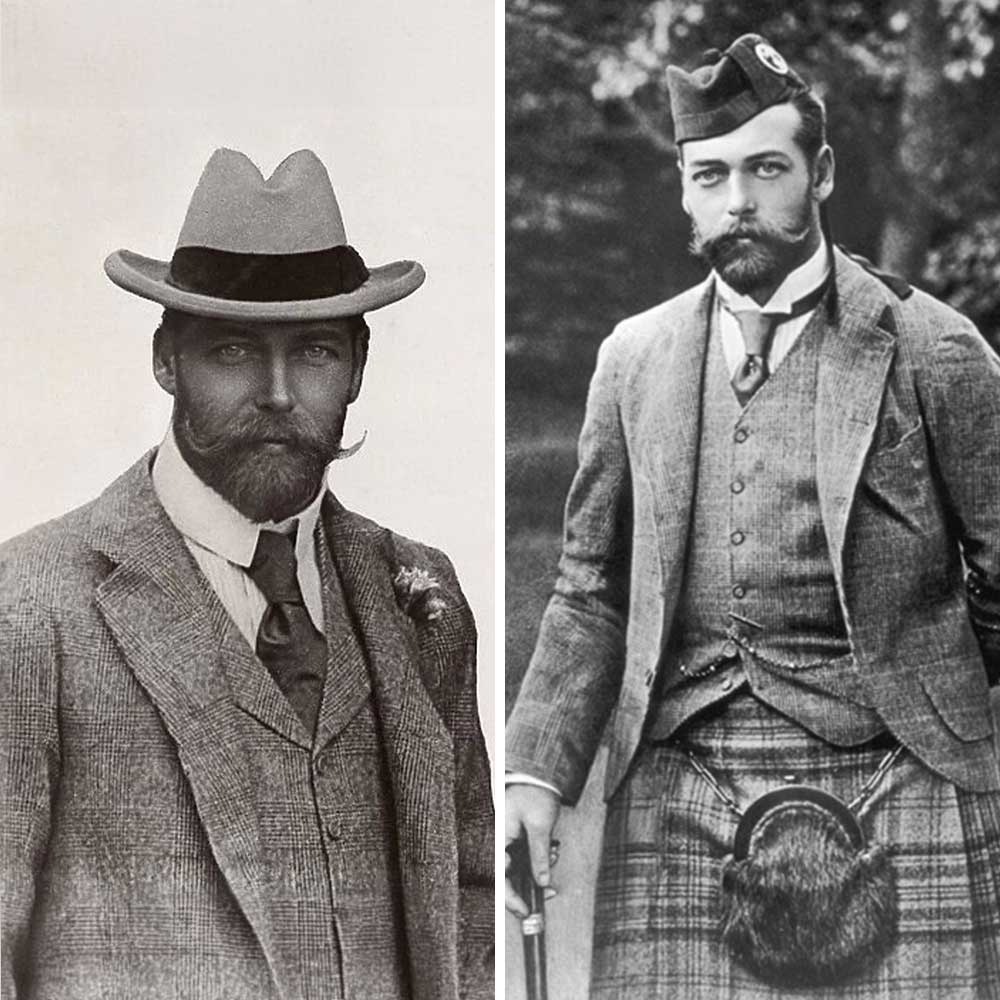
From the sturdy Tattersall check shirts and robust tweed jackets to the impeccably crafted brogues and Wellington boots, every element of British Country Chic serves a purpose while adhering to an unwritten code of rural elegance.
This style speaks of lineage, connection to the land, and a lifestyle that values tradition without eschewing practicality.
| Era | Influences | Garments |
|---|---|---|
| Pre-Victorian | Landed gentry, fox hunting | Riding coats, buckskin breeches |
| Victorian | Industrial Revolution, Scottish estates | Tweed suits, Norfolk jacket |
| Edwardian | Edward VII’s style, outdoor sports | Plus fours, Fair Isle sweaters |
| Interwar | Country house parties, motorsports | Driving coats, cricket jumpers |
| Post-WWII | Democratisation of Fashion | Barbour jackets, Hunter Wellington boots |
Pre-Victorian
The roots of British Country Chic stretch back to the early 19th century, when the landed gentry established a distinct dress code for their rural pursuits.
The pre-Victorian era saw the rise of fox hunting as a gentlemanly sport, introducing the scarlet hunting coat and white buckskin breeches as staples of the country wardrobe.
Victorian
As the Victorian age dawned, the Industrial Revolution significantly changed textile production.
The advent of mechanised looms allowed for the creation of hard-wearing fabrics like tweed, which quickly became synonymous with country attire.
The Scottish estates played a crucial role in this period, developing unique tweed patterns that served as a form of tartan for lowland families.
With its box pleats and belt, the Norfolk jacket emerged as a quintessential piece of Victorian country wear. Designed for shooting, its practicality and style made it a favourite among the rural elite.
This period also saw the introduction of the shooting brake, a specialised carriage that influenced the design of country clothing to accommodate gun-carrying.
Edwardian
The Edwardian era ushered in a more relaxed approach to country fashion, influenced heavily by Edward VII’s sartorial preferences.
The king’s penchant for plus fours – baggy knickerbockers that ended four inches below the knee – made them a staple of the country gentleman’s wardrobe.
Fair Isle sweaters, with their distinctive multicoloured patterns, also gained popularity during this time, adding a touch of whimsy to country ensembles.
Interwar
The interwar period saw the rise of the country house party, which brought a new glamour to rural fashion.
Cricket jumpers and tennis whites became part of the Country Chic lexicon, while the increasing popularity of motorsports introduced elements like driving coats and goggles to the rural wardrobe.
Post-WWII
Post-World War II, British Country Chic underwent a process of democratisation. Barbour’s waxed cotton jackets and Hunter’s Wellington boots made country style accessible to a broader audience.
This period also saw the influence of the Royal Family, particularly Prince Charles, in maintaining and promoting traditional country attire.
Throughout its evolution, British Country Chic has been shaped by iconic figures. Beau Brummell, the Regency dandy, set standards of neatness and restraint that still influence country style today.
The Duke of Windsor, known for his sartorial flair, popularised bold patterns and mixed textures in country wear.
The Scottish estates, particularly Balmoral and the Balmoral tartan designed by Prince Albert, became a symbol of royal country life and fashion.
At the same time, the rugged landscapes of the Highlands demanded sturdy, weatherproof clothing that has become emblematic of the Country Chic aesthetic.
Nowadays, the British Country Chic look combines garments, footwear, and accessories from past eras into a style that speaks of heritage, quality, and a deep connection to the British countryside.
British Country Chic Wardrobe Essentials
| Category | Key Component | Specific Materials |
|---|---|---|
| Outerwear | Tweed jacket, Waxed cotton coat, Gilet | Harris Tweed, Barbour waxed cotton, Cordings |
| Shirts | Tattersall check, Oxford button-down | Brushed cotton, Sea Island cotton |
| Trousers | Corduroy, Moleskin, Plus fours | Bedford cord, Cavalry twill |
| Knitwear | Cable knit sweater, Fair Isle vest | Shetland wool, Merino lambswool |
| Footwear | Brogue boots, Wellington boots | Box calf leather, Vulcanised rubber |
| Accessories | Tweed flat cap, Silk pocket square | Donegal tweed, Ancient Madder silk |
Outerwear – The Tweed Jacket
The tweed jacket is undoubtedly the cornerstone of any British Country Chic wardrobe.
With roots in the Scottish Highlands, tweed is a strong fabric designed to withstand harsh weather conditions.
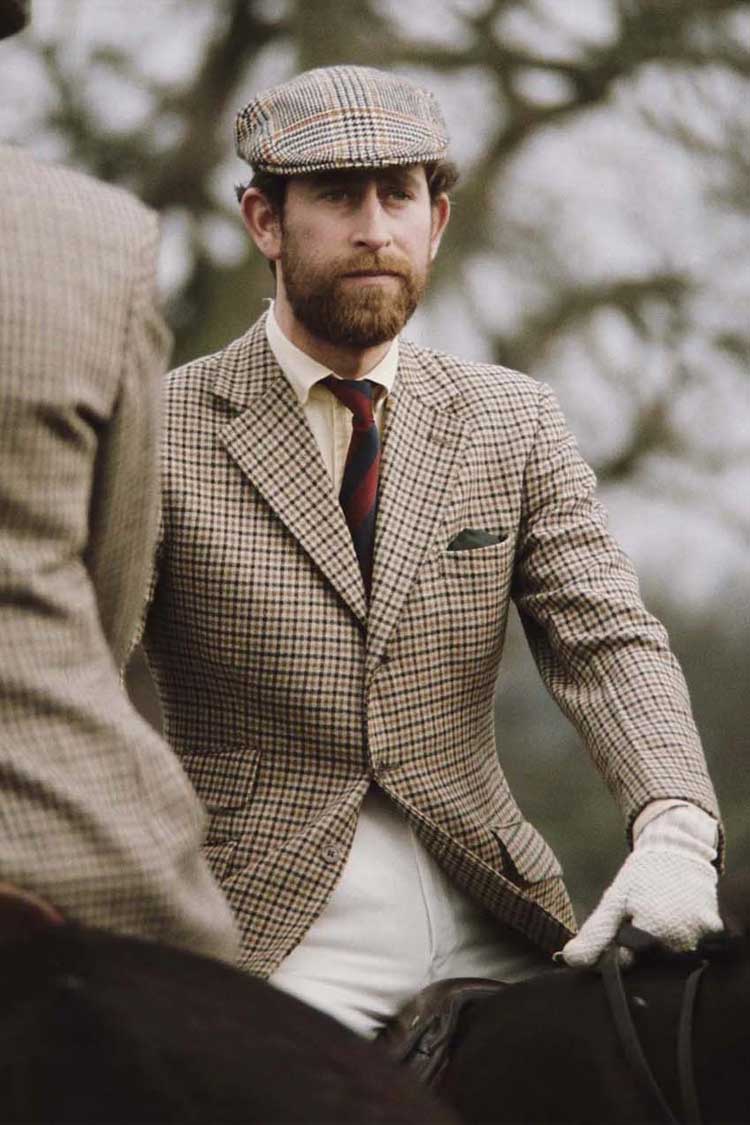
The iconic Harris Tweed, hand-woven in the Outer Hebrides, is the pinnacle of tweed craftsmanship.
A classic tweed jacket features a three-button front, notched lapels, and flapped pockets.
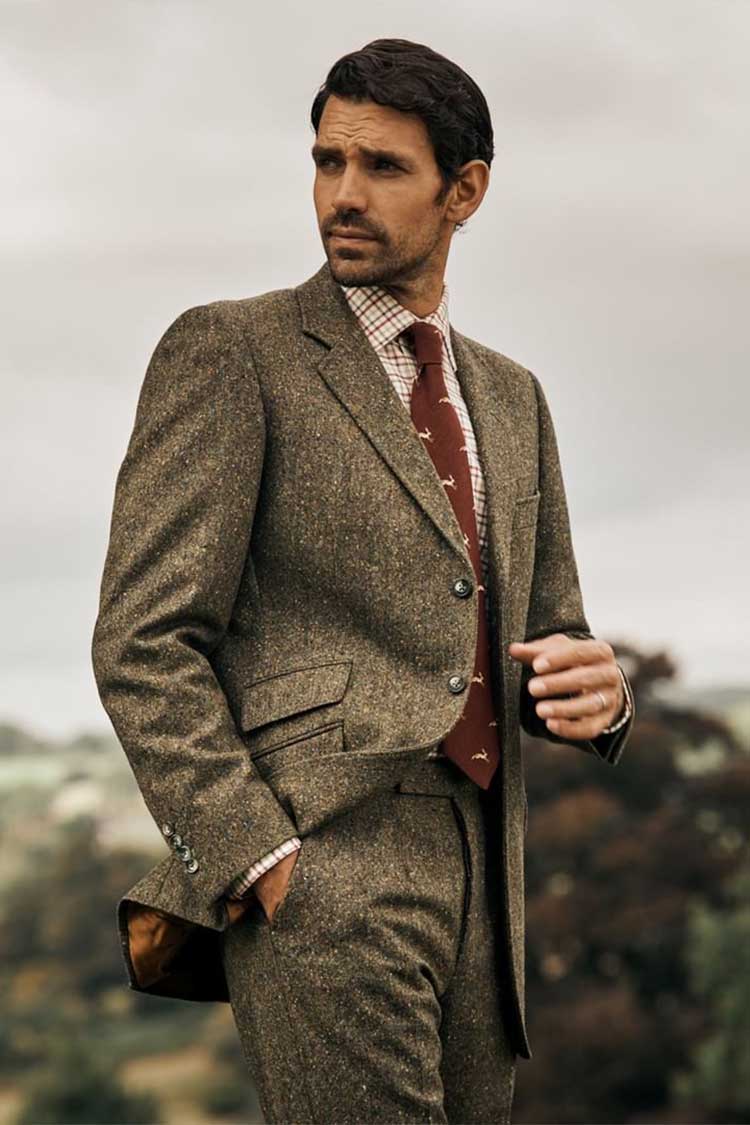
The Norfolk jacket is a tweed jacket variation with a belted waist and box pleats designed for enhanced mobility for shooting.
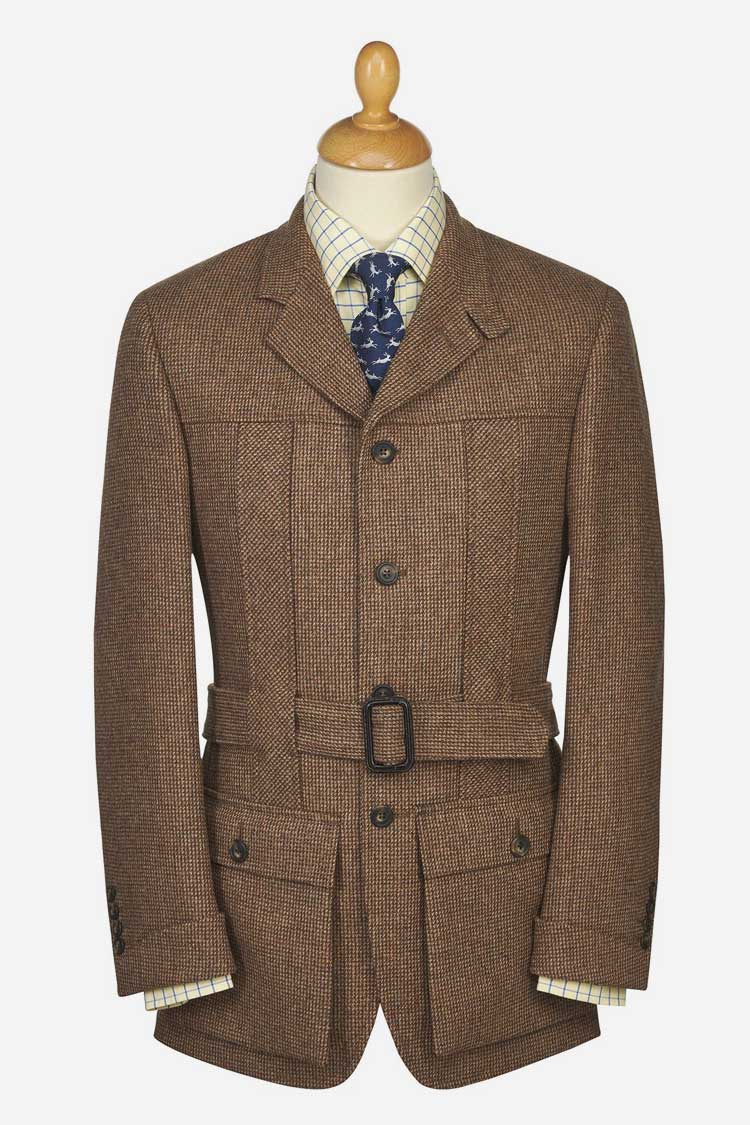
Tweed jacket colours mirror the landscape such as moss greens, heather purples, and earthy browns enlivened with a subtle overcheck in contrasting hues.
The tweed jacket is almost always completed by the waxed cotton coat, an essential outerwear pioneered by British brands like Barbour.
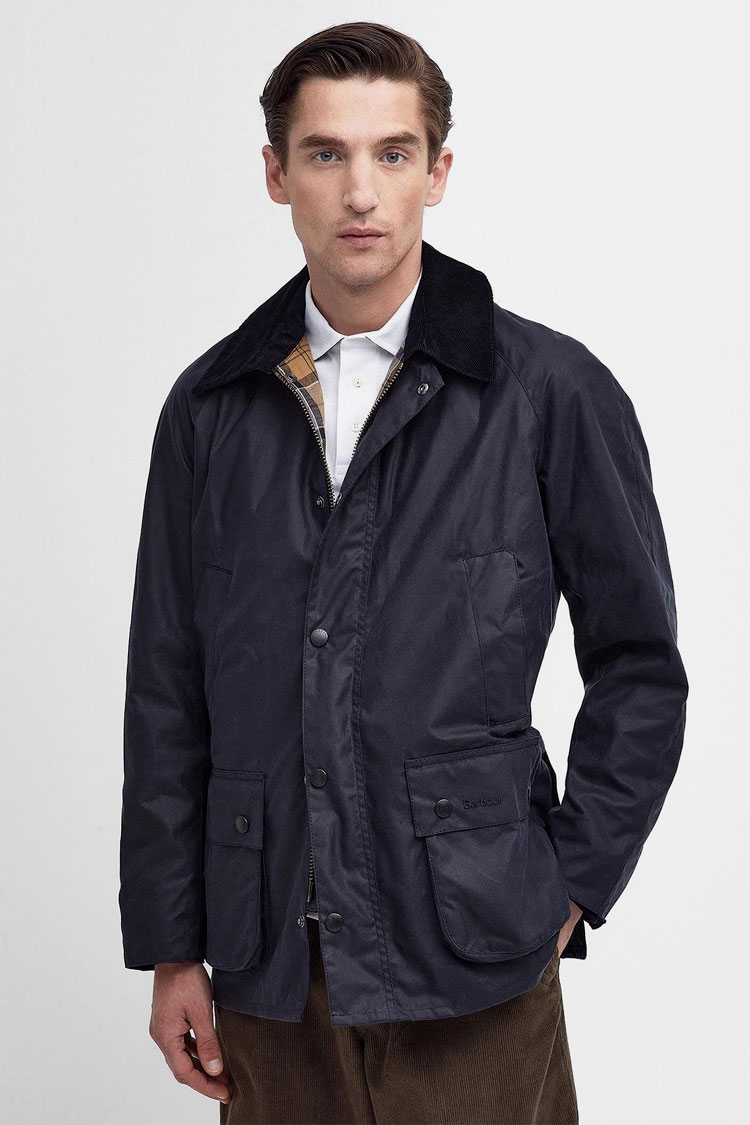
These countryside outerwear coats have a waxed cotton outer layer that repels water, allowing breathability.
The classic Barbour Beaufort coat exemplifies the style with its corduroy collar and multiple pockets.
Shirts – Tattersall Checks and Oxford Cloth
The Tattersall check shirt, with a distinctive pattern of evenly-spaced thin lines forming squares, is a staple of country attire.

Initially designed for horse blankets at London’s Tattersall’s horse market, the pattern was adopted for shirting in the early 20th century.
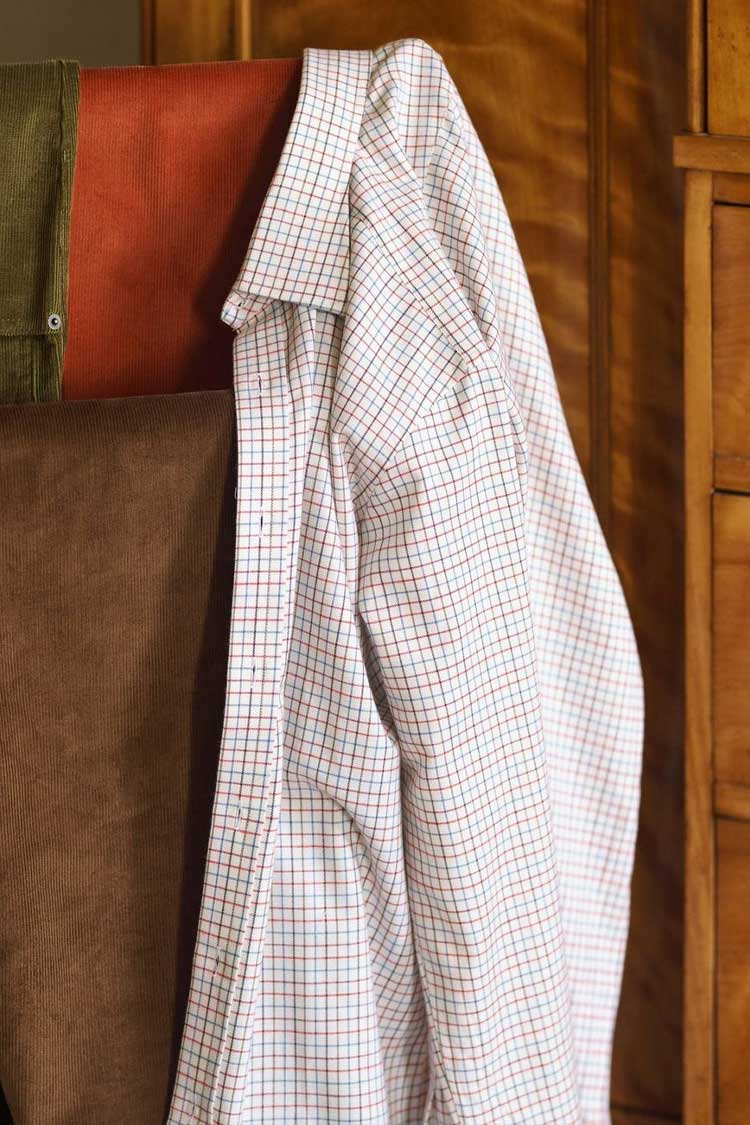
Crafted from brushed cotton for warmth, these shirts typically feature earthy base colours like cream or pale yellow, with checks in greens, reds, or blues.
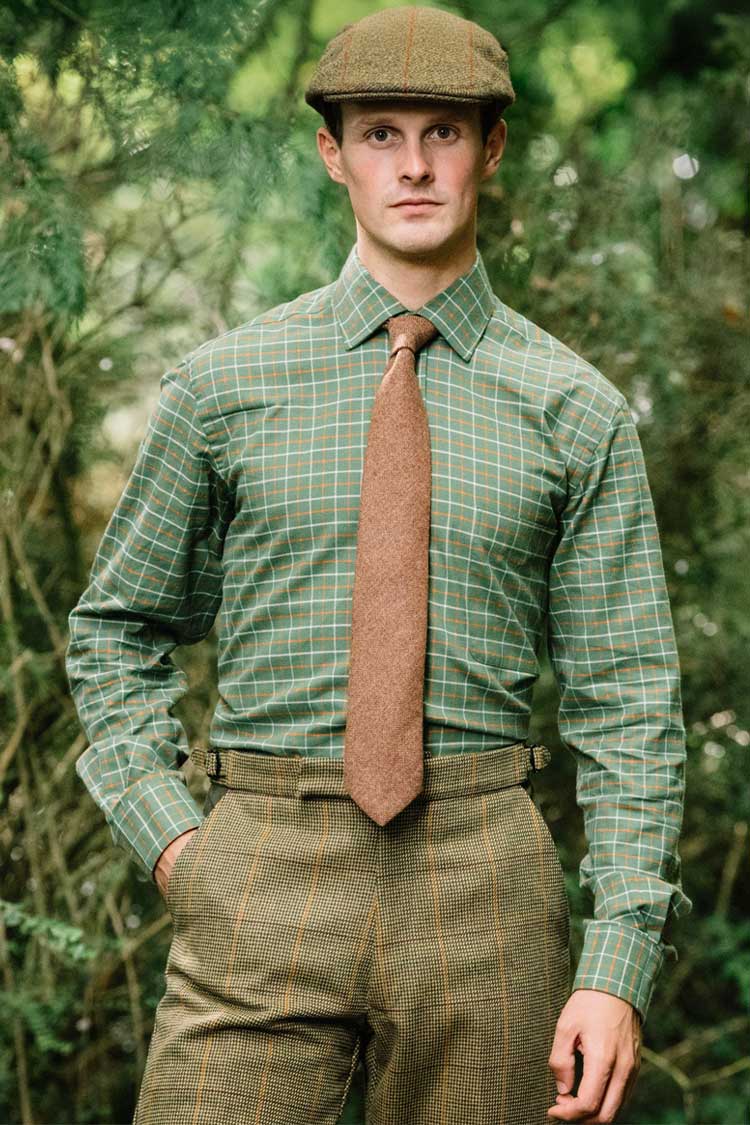
For a more formal look, the Oxford button-down shirt in Sea Island cotton provides a refined alternative.
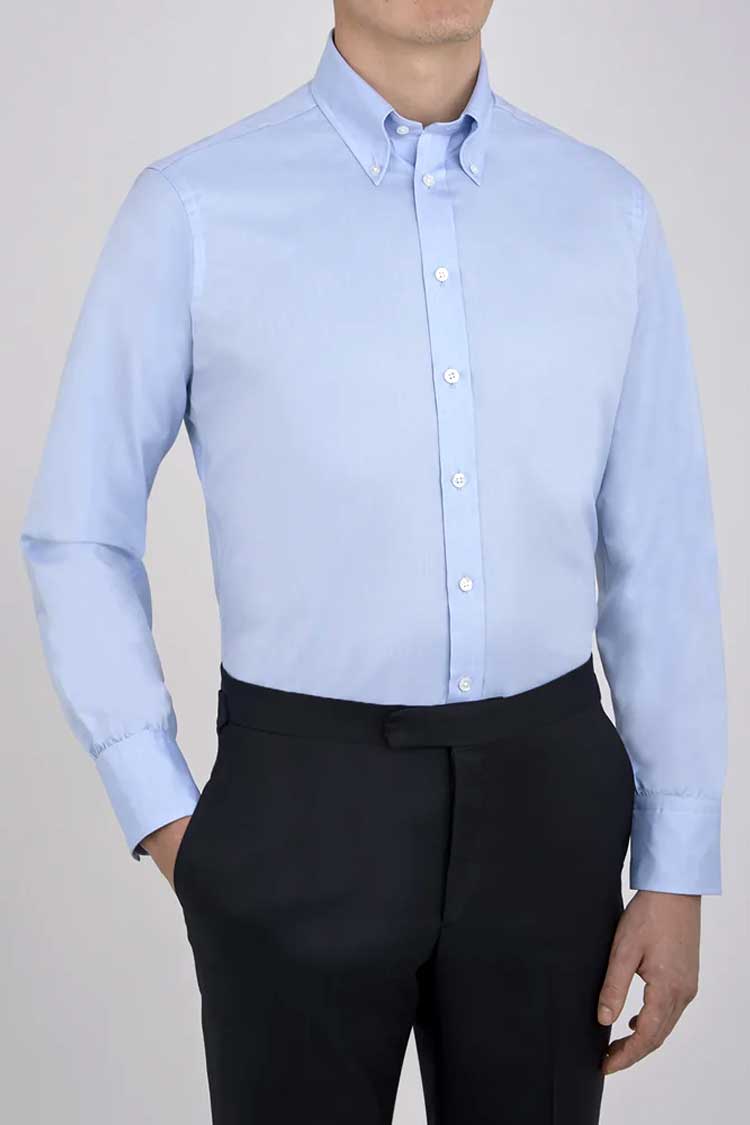
The button-down collar, an American innovation adopted by the British, keeps the collar in place during rigorous country pursuits.
Trousers – From Corduroy to Plus Fours
The British Country Chic wardrobe boasts a variety of trouser styles, each with unique characteristics and purposes.
Corduroy trousers, with their distinctive ridged texture, are a country classic. The width of the ridges, known as the ‘wale’, varies from fine needle cord to broad jumbo cord.
These trousers offer warmth and durability, ideal for cooler weather and outdoor activities.
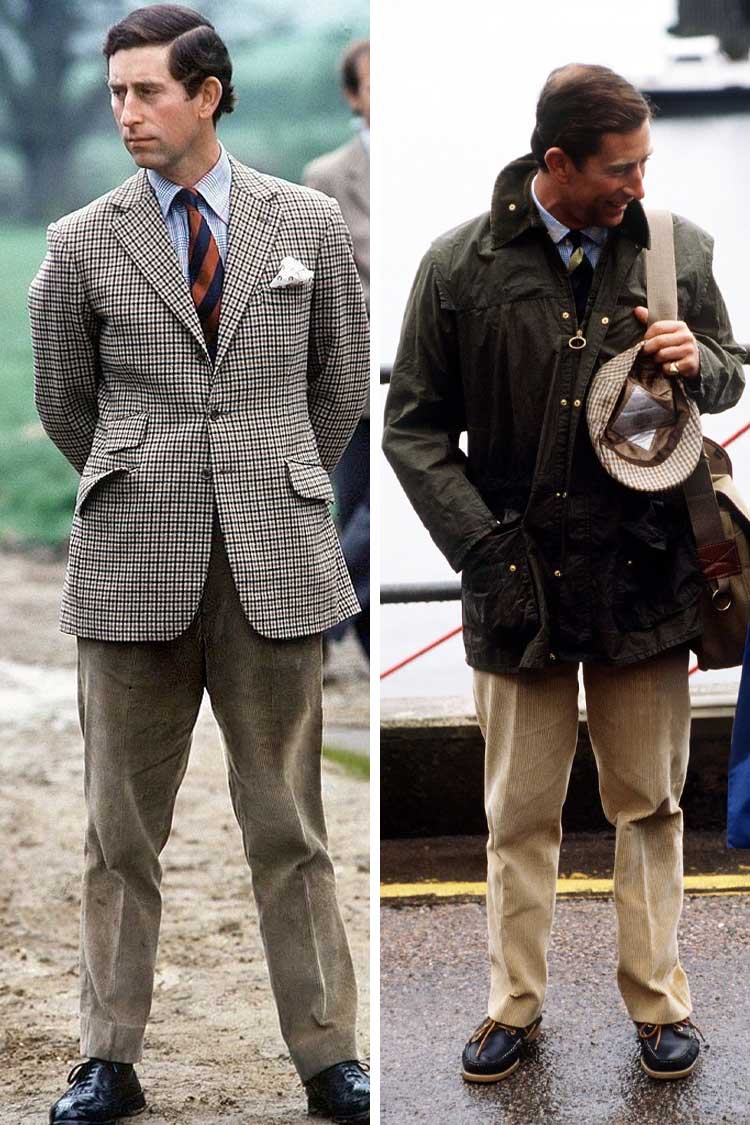
Moleskin trousers, despite their name, are not made from animal skin but from heavy cotton fabric with a soft, suede-like feel.
Moleskin provides excellent warmth and wind resistance, making these trousers popular for country pursuits in harsh weather.
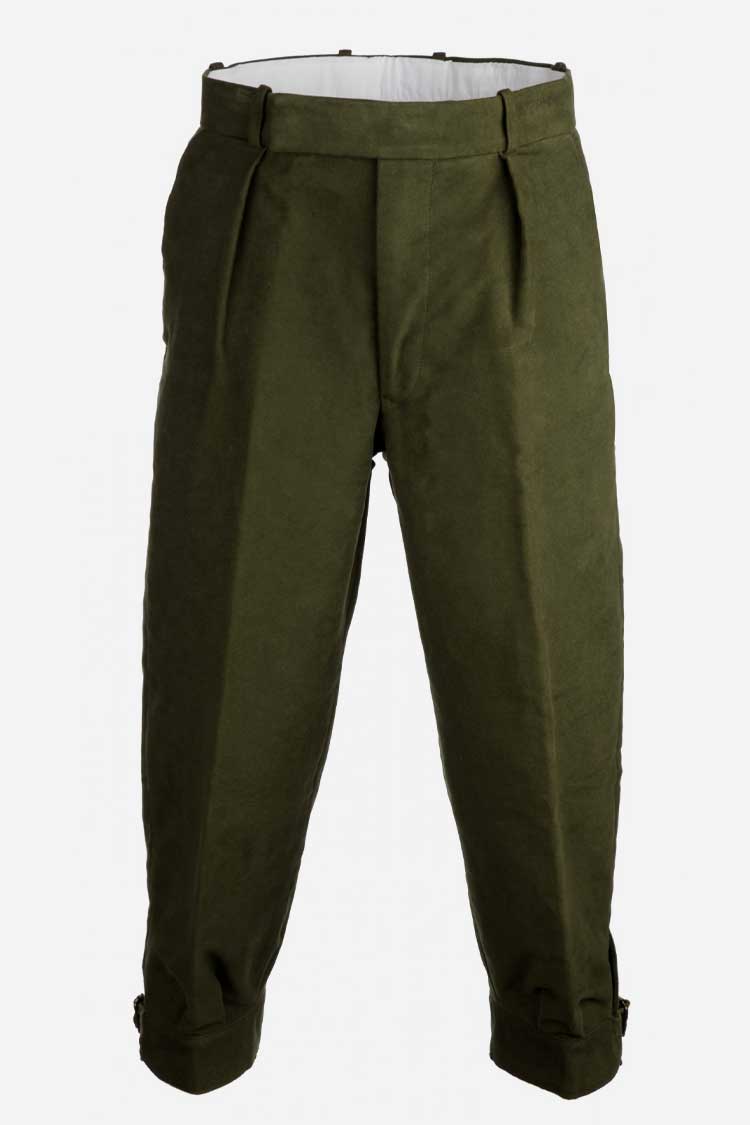
For sporting activities, Plus Fours remain a distinctive choice. These knee-length breeches, famously favoured by Edward VIII, allow freedom of movement for activities like shooting or golf.
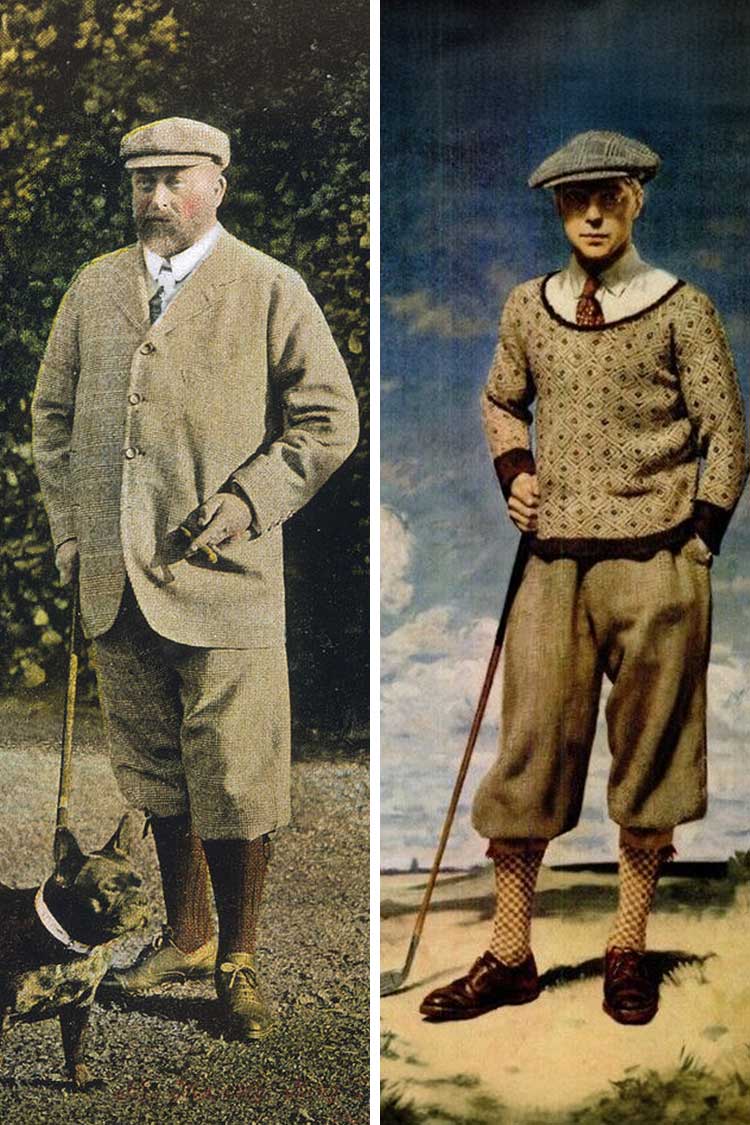
Traditionally made from tweed or cavalry twill, Plus Fours are worn with knee-high socks in classic argyle or cable knit patterns.
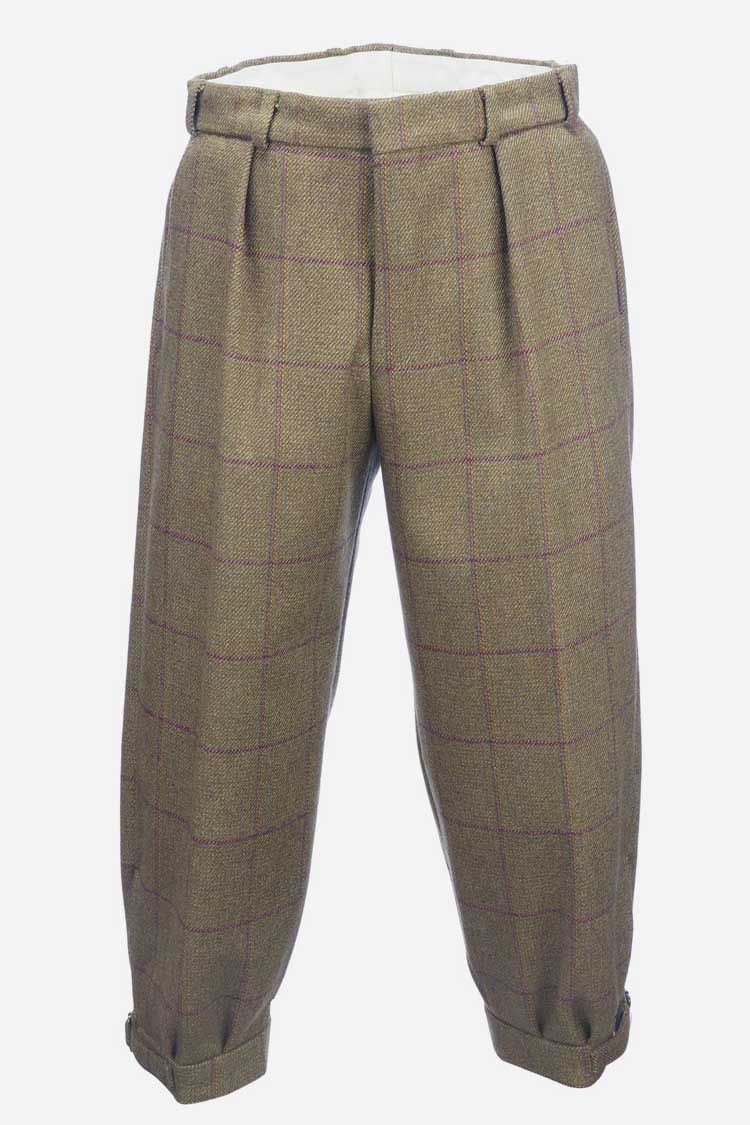
Each of these trouser styles plays a specific role in the country wardrobe, offering options for different activities and weather conditions.
Corduroy and moleskin excel in everyday country wear, while plus fours are reserved for specific sporting events.
Knitwear – Cable Knits and Fair Isle Patterns
Cable-knit sweaters, featuring intricate twisted rope patterns, originate from the fishing communities of the Aran Islands.
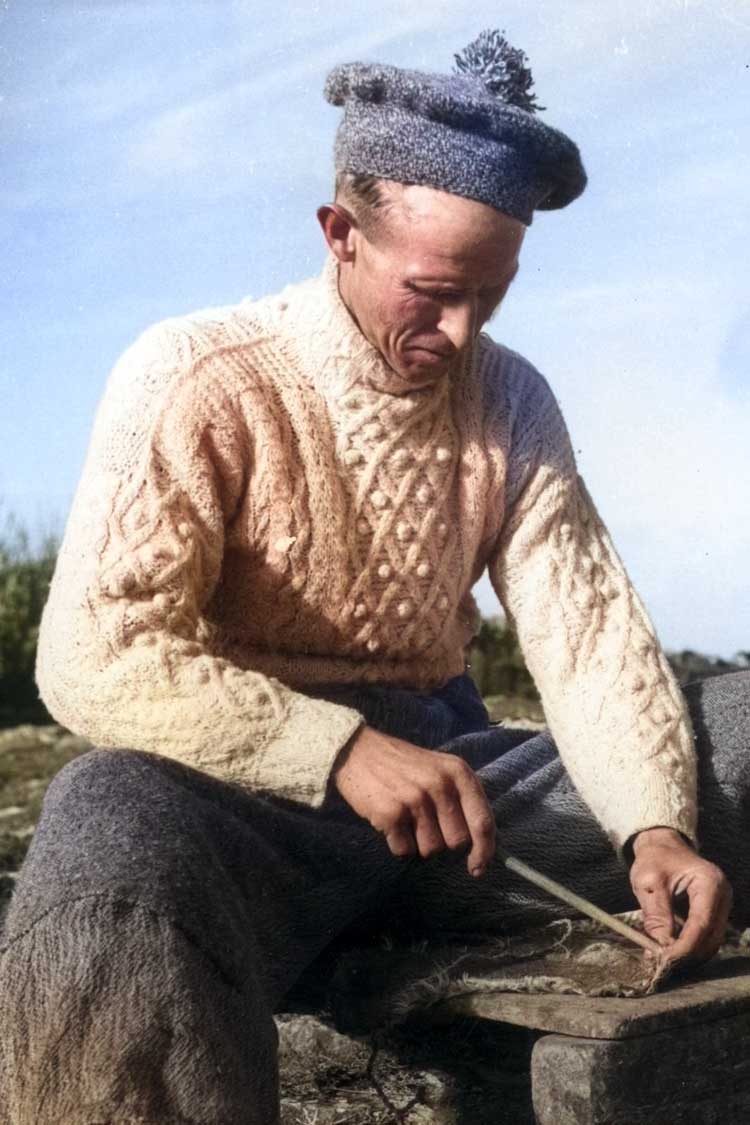
British Country Chic adopts these sweaters in Shetland or Merino wool, favouring colours like cream, navy, royal purple, and forest green.
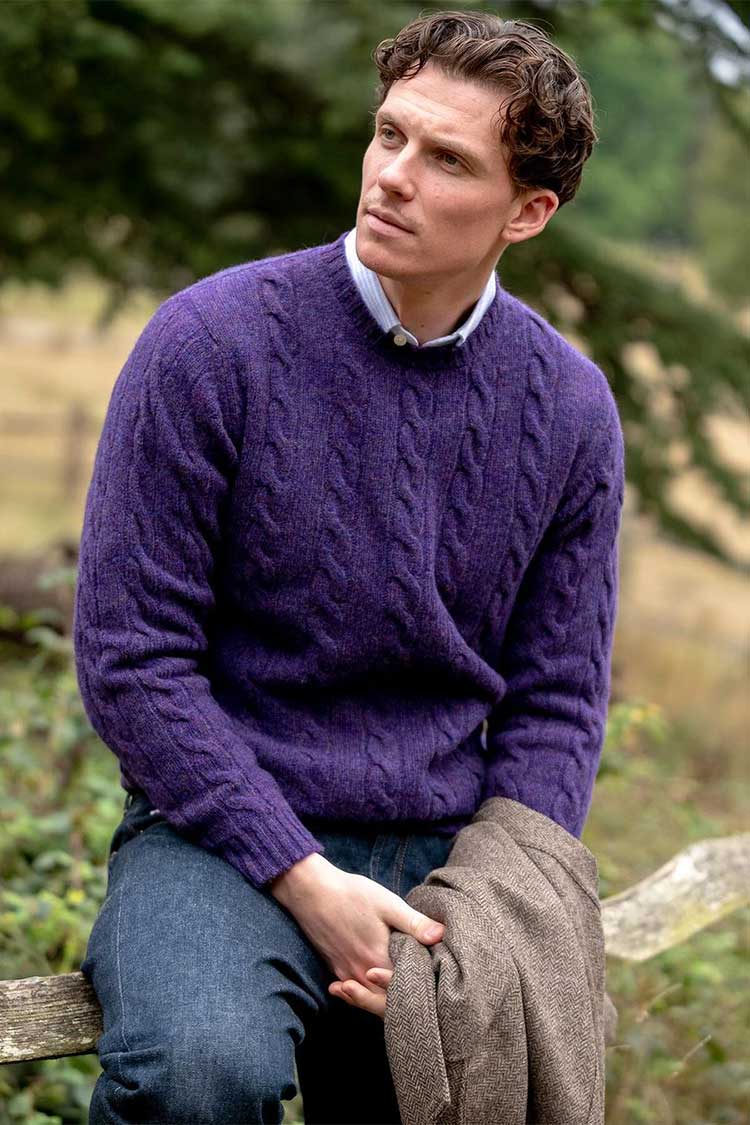
Fair Isle knitwear, known for its distinctive multicoloured patterns, hails from the Shetland Islands.
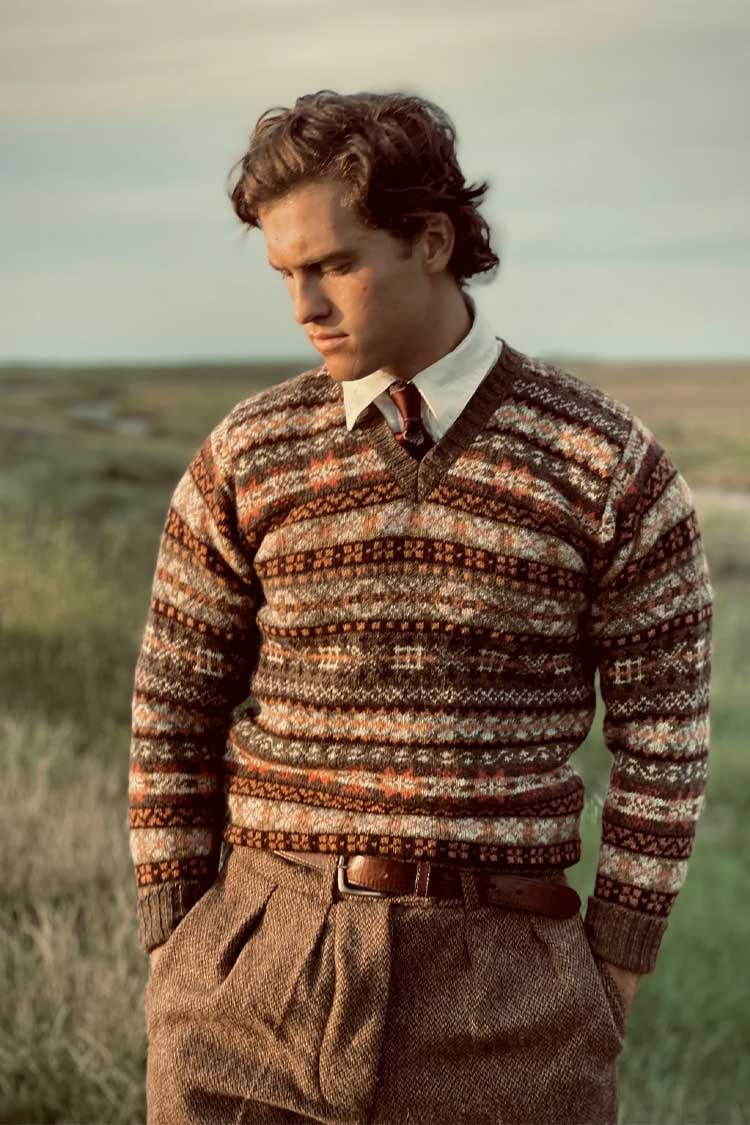
Fair Isle sweaters, vests, or tank tops are worn over shirts to inject vibrant patterns into country ensembles.
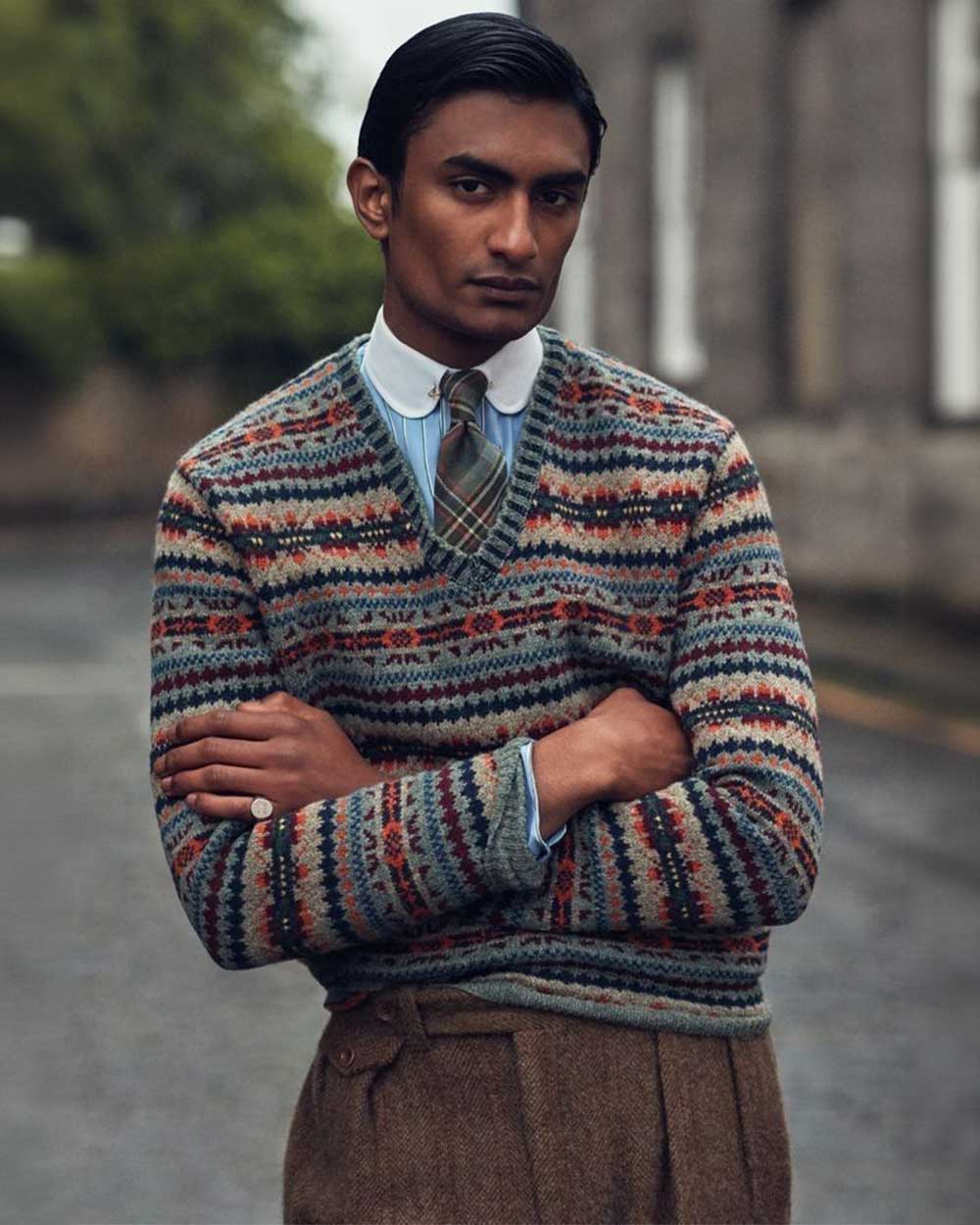
These intricate designs often incorporate local motifs such as anchors or snowflakes, adding an unexpected touch of maritime heritage to the country chic style.
Footwear – Brogues and Wellingtons
Brogues, distinguished by their decorative perforations (known as ‘broguing’), form a cornerstone of country footwear.
Originally designed for water drainage in boggy Scottish terrain, brogues have evolved into stylish modern shoes for business-casual events.
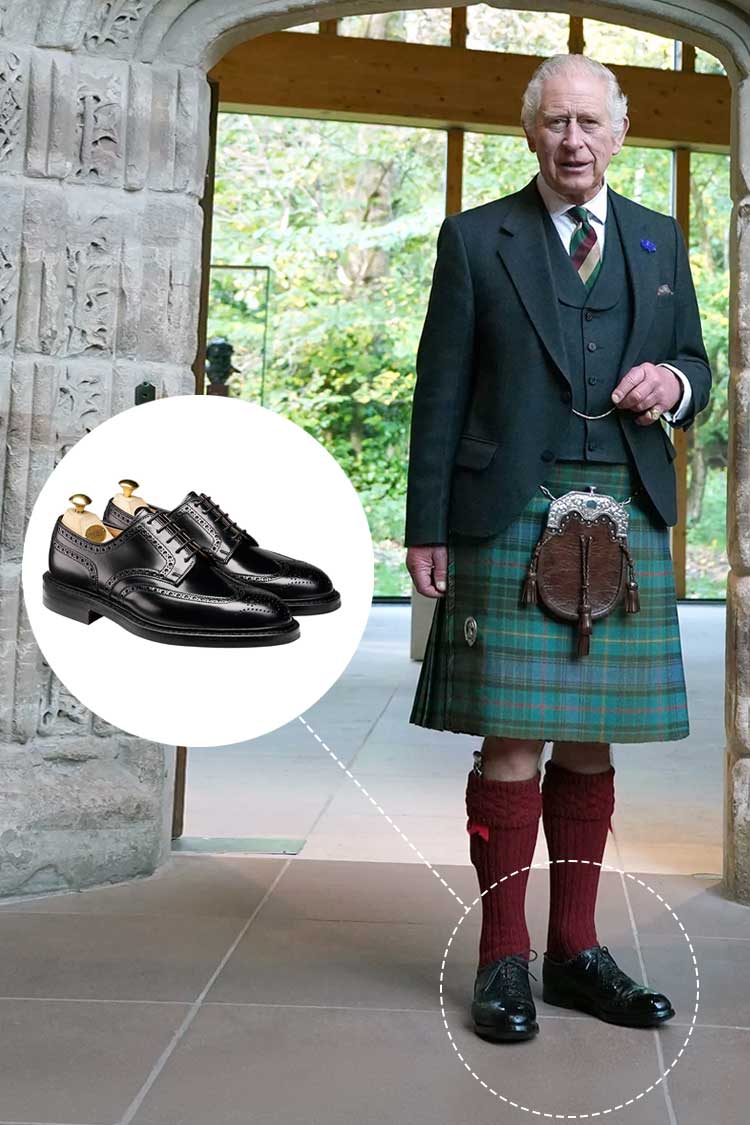
The classic country brogues with a wingtip design in water-resistant box calf leather and rich tan or oxblood are preferred.
Wellington boots, named after the 1st Duke of Wellington, are indispensable for muddy country pursuits.
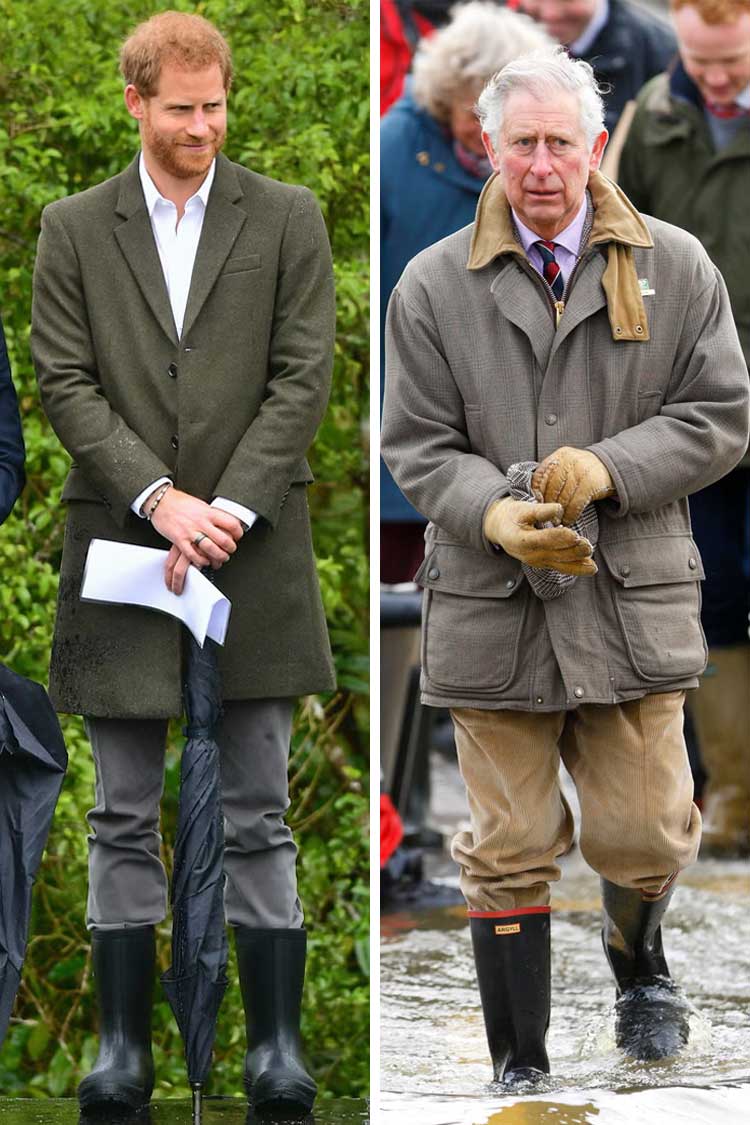
While traditional wellies use vulcanised rubber, modern versions incorporate neoprene for enhanced comfort.
Hunter’s Original Tall Boot, in classic green or navy, remains the quintessential choice for the country gentleman.
Accessories
The preferred headwear is the tweed flat cap, particularly in Donegal or Baker Boy.
These caps feature a short brim and an eight-paneled crown, culminating in a button at the top.

Neckwear plays a pivotal role in British Country Chic. Formal occasions call for ancient Madder silk ties with muted paisley patterns, perfectly complementing tweed jackets.
For a more casual approach, wool challis ties in tartan patterns infuse a touch of Scottish heritage.
A silk pocket square, artfully arranged in the breast pocket of a tweed jacket, provides the finishing flourish.
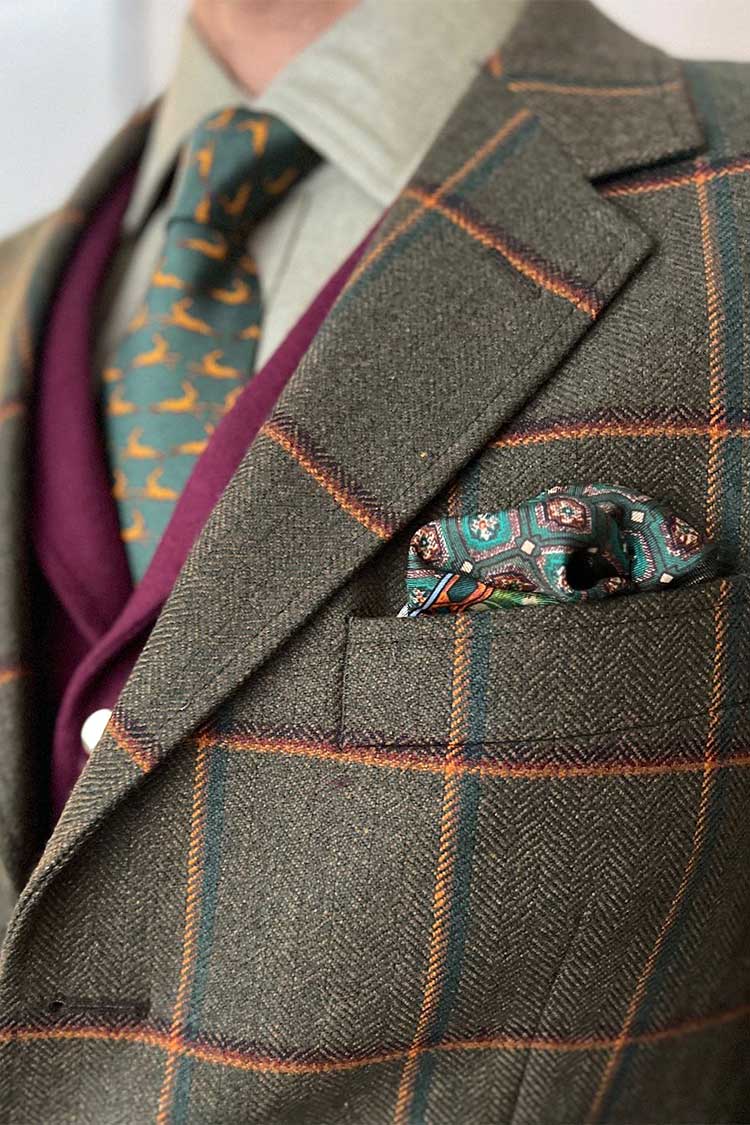
Paisley patterns or subtle foulard prints in colours that harmonise with, rather than precisely match, the tie complete the polished country look.
British Country Chic Aesthetic
| Colours | Patterns | Mixing Guidelines |
|---|---|---|
| Earth tones: browns, greens, russets | Tweed herringbone, glen plaid | Match scale, vary pattern types |
| Muted hues: heather purple, slate blue | Tattersall check, houndstooth | Coordinate colours across patterns |
| Accent colours: burgundy, mustard | Argyle, Fair Isle | Use them to break up patterns |
Colours
The colour palette of British Country Chic draws direct inspiration from the British countryside.
Earth tones form the foundation of this style. Rich browns mirror the soil of freshly ploughed fields, while varied greens echo the lush landscapes of rolling hills and dense forests.
Russet reds and warm oranges evoke autumn leaves, adding depth to the palette.
Muted hues like heather purple, reminiscent of Scottish moorlands, and slate blue, reflecting overcast skies, play a crucial role in the British country chic aesthetic.
Accent colours such as deep burgundy, seen in silk ties or pocket squares, add elegance and vibrancy to country ensembles.
Mustard yellow, used sparingly in knitwear or accessories, brings warmth to the overall look.
Patterns
Tweed is the canvas for most country chic patterns. The herringbone weave, easily recognised by its distinctive V-shaped pattern, is a tweed classic.
Glen plaid, also known as Prince of Wales check, features a woven twill design of small and large checks, often in black and white with a coloured overcheck.
Tattersall checks, consisting of evenly spaced horizontal and vertical lines forming squares, feature prominently in country shirts.
Houndstooth, characterised by a broken check pattern, often appears in jackets or overcoats.
Argyle, with its distinctive diamond pattern, is a staple in country knitwear and socks.
Fair Isle patterns, known for their intricate and colourful designs, add visual interest to sweaters and vests.
Seasonal Considerations
The colour palette shifts subtly with the seasons.
Spring and summer introduce lighter hues—sage greens, sky blues, and warm tans predominate.
Autumn and winter bring forth deeper, richer tones—forest greens, burgundies, and deep browns take centre stage.
Pattern mixing adapts to seasonal changes, too.
Lighter, more open weaves and patterns suit warmer months, while denser, more complex patterns provide visual warmth in colder seasons.
Mastery of colour theory and pattern mixing in British Country Chic allows endless variation within a defined aesthetic.
This nuanced approach to dressing sets the country gentleman apart, demonstrating an understanding of tradition and an eye for subtle sophistication.
British Country Chic Outfit Ideas by Season
Spring
The spring country gentleman opts for a lightweight tweed jacket in a pale sage green with a subtle blue overcheck.
Pair the jacket with stone-coloured cotton drill trousers cuffed at the ankle and a sky-blue Oxford button-down shirt underneath.
Wear suede brogue boots in a rich tobacco shade, complemented by olive green wool socks and a silk pocket square in a paisley print in shades of blue and green.
Completed with a brown leather belt and a woven wool tie in a muted yellow, echoing the first daffodils of the season and a tweed flat cap in a herringbone pattern that matches the jacket.
Summer
For the summer months, select a cream linen single-breasted jacket with mother-of-pearl buttons.
Match this with light grey tropical wool trousers featuring a crisp front crease and layer a pale pink Sea Island cotton shirt with a cutaway collar underneath for a fresh look.
Slip into tan suede loafers without socks to embrace the season’s warmth. For subtle colour accents, add a golden silk knit tie and a linen pocket square in sky blue.
Crown the ensemble with a Panama hat adorned with a navy band, offering style and sun protection for those long summer days in the countryside.
Autumn
As the leaves turn, don a russet brown thornproof tweed jacket with a bold orange and forest green overcheck.
Pair this statement piece with dark olive moleskin trousers, their soft texture contrasting beautifully with the rougher tweed.
Layer a cream Tattersall check shirt with a rust red and hunter green pattern underneath, complementing the autumnal palette. Add a lambswool sweater vest in deep mustard for extra warmth.
Ground the outfit with chestnut brown brogue boots and thick wool socks in forest green. Finish with a silk tie in deep burgundy, a coordinating wool pocket square, and a waxed cotton flat cap in olive to protect from autumn winds.
Winter
For the coldest months, wear a heavy charcoal-grey Harris Tweed jacket with a subtle blue and red overcheck over a cream Aran knit sweater.
Wear a brushed cotton shirt in a red and black gingham check and cavalry twill trousers in a deep navy tucked into green Hunter Wellington boots; let thick wool socks in a Fair Isle pattern peek above the boot tops.
Accessorise with a dark green cashmere scarf and a matching tweed flat cap. Complete the look with dark brown leather gloves.
For particularly frosty days, tuck a tortoiseshell hip flask filled with sloe gin (or your favourite drink) into the jacket’s game pocket.
British Country Chic Styling Rules
| Do | Don’t |
|---|---|
| Wear traditional fabrics like tweed and waxed cotton | Wear modern or synthetic materials |
| Mix patterns | Match patterns exactly |
| Buy traditional garments of quality | Buy fast fashion or trendy clothes |
| Respect dress codes for country events | Underdress for formal country occasions |
| Layer for changing weather | Sacrifice practicality for style |
Do
Wear traditional fabrics
Tweed, waxed cotton, and moleskin form the backbone of British Country Chic. These materials not only look authentic but also offer practicality in country settings.
Mix patterns with confidence
Combine a tweed jacket with a tattersall shirt and a paisley tie. The key is to vary the scale of the patterns and ensure a common colour thread runs through the ensemble.
Buy quality, durable garments
British Country Chic values longevity. A well-made tweed jacket or a pair of quality leather brogues will serve you for years, developing character with age.
Adhere to dress codes for country events
Different activities call for specific attire. Shooting requires certain safety considerations, while a country wedding demands appropriate formality.
Layer effectively
The British weather demands adaptability. To stay comfortable throughout the day, you must know how to layer with gilets, sweaters, and jackets.
Don’t
Don’t wear modern or synthetic materials
Neon colours or high-tech fabrics look out of place in a country setting. Stick to natural fibres and traditional colour palettes.
Don’t match patterns exactly
Coordination should appear effortless, not contrived. Avoid wearing the same pattern in different items of clothing.
Don’t wear fast fashion or trendy clothes
British Country Chic is about timeless style, not fleeting trends. Resist the urge to incorporate the latest fashion fads into your country wardrobe.
Don’t underdress for formal country occasions
Events like shooting parties or hunt balls have specific dress codes. Familiarise yourself with these expectations and dress accordingly.
Never sacrifice practicality for style
While appearance matters, function remains paramount in country settings. Ensure your attire can withstand the rigours of outdoor activities and unpredictable weather.
British Country Chic Brands
Barbour
Barbour, established in 1894, is known for its iconic waxed cotton jackets crafted in South Shields, England.
The brand has royal warrants from Queen Elizabeth II, the Duke of Edinburgh, and the Prince of Wales, and its jackets feature patented thornproof fabric introduced in 1921.
Hunter
Hunter, founded in 1856, is famous for its Original Wellington Boots.
These boots gained recognition during World War I when commissioned by the War Office for soldiers in the trenches.
The brand has been a favourite of the British Royal Family since the mid-20th century.
Holland Cooper
Holland Cooper, founded in 2008 by Jade Holland Cooper, specialises in luxurious tweed garments.
The brand sources its wool from the finest Scottish mills and is known for contemporary designs blending traditional British tailoring with modern style, particularly in equestrian-inspired collections.
William Crabtree
William Crabtree, established in 1914, is celebrated for heritage and modernity in crafting country attire.
The brand’s unique patterns are inspired by the English rural landscape, known for meticulous attention to detail and the use of high-quality materials.
Cordings
Cordings of Piccadilly, established in 1839, is renowned for its quintessential British country style, particularly its tweed suits and coats.
The brand uses Teflon-coated fabrics for enhanced durability and has been patronised by notable figures, including Eric Clapton, who became a co-owner in 2003.
E.J. Churchill
E.J. Churchill, founded in 1891, is synonymous with premium shooting attire.
The brand offers bespoke shooting suits and accessories combining functionality with classic British elegance.
E.J. Churchill is also famous for its state-of-the-art shooting ground in Buckinghamshire.
Crockett & Jones
Crockett & Jones, established in 1879, is known for high-quality handcrafted footwear. The brand’s Coniston boot, among other styles, exemplifies traditional British craftsmanship.
Crockett & Jones shoes are made using the Goodyear welted construction, ensuring durability and comfort, and are favoured by discerning customers worldwide.
British Country Houses
British country houses have played a pivotal role in shaping country chic fashion.
These grand estates, with their rich histories and distinct architectural styles, have long been the backdrop for country pursuits and social gatherings, influencing the development of rural fashion.
Balmoral Castle
The Scottish retreat of the British Royal Family, Balmoral has significantly influenced country style.
Prince Albert’s design of the Balmoral tartan in 1853 cemented the connection between royalty and Highland dress.
The castle’s rugged Highland setting necessitated robust, weather-resistant clothing, contributing to the popularity of tweeds and waxed jackets in country wardrobes.
Chatsworth House
Home to the Dukes of Devonshire, Chatsworth embodies the grandeur of English country houses.
The estate’s annual horse trials have been instrumental in popularising equestrian-inspired fashion elements, such as jodhpurs and riding boots, in everyday country wear.
Highclere Castle
Better known as the filming location for Downton Abbey, Highclere Castle represents the Edwardian era’s influence on country fashion.
The series showcased the transition from formal Victorian dress to the more relaxed, yet still elegant, country attire of the early 20th century, reviving interest in period-inspired country fashion.
Holkham Hall
This Norfolk estate, with its extensive parkland and beach, has been at the forefront of country sports fashion.
The annual Holkham Country Fair showcases the latest in country and equestrian wear, influencing trends in practical outdoor clothing.
British Country Chic is a testament to the enduring appeal of rural British style and embodies a lifestyle steeped in tradition and appreciation for the countryside.
From the tweed jackets that withstand blustery moors to the stylish pocket squares, every British Country Chic piece has a purpose while showcasing rural refinement.
The style’s ability to blend functionality with aesthetics ensures its relevance in country and urban settings.
By mastering the art of layering, understanding the nuances of pattern mixing, and investing in quality pieces, one not only dresses appropriately for country pursuits but also carries a piece of British heritage.
The influence of iconic country houses and their inhabitants continues to shape and reinforce these style traditions.
In an age of fast fashion and fleeting trends, British Country Chic offers a refreshing alternative – a style that values longevity, craftsmanship, and a deep connection to the land.
Whether striding across misty fields or navigating urban landscapes, those who embrace this style carry the essence of British rural elegance, proving that true style transcends time and place.
Style with The VOU
Knowing the look of British Country Chic fashion and the names of some expensive brands is one thing.
But knowing how to match them according to your seasonal colour and body shape…well, that’s a different thing.
True fashion mastery lies in knowing and matching your body shape/type with your seasonal colour – skin, eye, and hair colours.
It requires understanding how to shop and pair the most ideal garments, footwear, and accessories from the most relevant, heritage brands.
This is paramount to being able to dress correctly by body shape, occasion, location, time of the day, and lifestyle.
Find Your Body Shape
Different garments flatter different physiques so discover your body shape now by taking our free body shape quiz for men.
Identify Your Best Colors
Fashion comes in a wide range of colours, but not every hue will complement your natural colouring so find out your ideal colours with our free seasonal colour quiz for men.
Then, learn how to dress by occasion, location, season, and even time of the day.
Dress for the Occasion
Understanding how to choose and style garments from relevant heritage brands, and style them by occasion, season, location, and body shape is crucial.
From casual weekends to formal events, each occasion requires a unique approach to styling.
To save time, headaches, and even money, get in touch with The VOU’s expert stylists now.
Get Expert Styling Advice
Take our comprehensive fashion style analysis for men, and let our expert stylists guide you in selecting and curating items of maximum impact in a wardrobe that communicates success and confidence.
Our team of seasoned stylists will curate a bespoke capsule wardrobe that reflects your tastes and aspirations while honouring the time-honoured traditions of the equestrian world.
Remember, owning luxury brands isn’t enough. To look stylish, confident, wealthy, and successful you must match your body shape, colour palette, season, occasion, location, time of the day, to perfection.
With these tools and expert guidance, you’ll not just wear the brand—you’ll master it, creating a wardrobe that truly reflects a unique fashion taste and many achievements.


